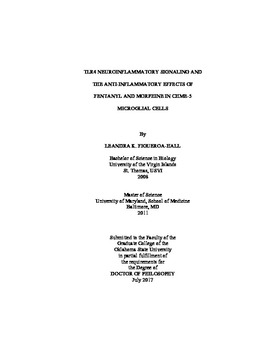| dc.contributor.advisor | Davis, Randall L. | |
| dc.contributor.author | Figueroa-Hall, Leandra K. | |
| dc.date.accessioned | 2018-04-23T19:35:15Z | |
| dc.date.available | 2018-04-23T19:35:15Z | |
| dc.date.issued | 2017-07 | |
| dc.identifier.uri | https://hdl.handle.net/11244/299510 | |
| dc.description.abstract | Microglia are instrumental in neuroinflammation, which is a key factor in neuronal damage in many neurological disorders. Pro-inflammatory mediators activate these cells, including bacterial lipopolysaccharide (LPS) that signals through toll-like receptor 4 (TLR4). In the field of neuroinflammation, identifying the specific effects of pharmacological agents and other factors on microglia is often problematic given the difficulty and expense in obtaining and culturing primary microglia. Thus, immortalized microglial cell lines are very useful. Therefore, characterization of LPS-induced TLR4 signaling in the CHME-5 microglial cell line was expected to be of value as an experimental model of inflammatory signaling in the central nervous system (CNS). Inflammatory signaling in response to Escherichia coli LPS induced IkBa and NF-kB p65 activation, NF-kB p65 binding activity, and TNFa gene expression. We confirmed the maintenance of microglial phenotype as seen with increased CD68 expression and the absence of GFAP-immunoreactivity. TLR4 expression was significantly increased after LPS treatment. Another family of receptors expressed in the CNS is the opioid receptors, which are guanine protein coupled receptors (GPCRs) and mediate their effects with the binding of opioids. Most notably, the mu opioid receptor (MOR) is expressed in many organ systems and binds opioid agonists, morphine and fentanyl, and antagonists, naloxone and naltrexone. Research shows that opioids modulate immune function, and therefore, our goal was to determine the effects of fentanyl and morphine on LPS-induced TLR4 signaling in CHME-5 cells. Co-treatment with LPS and fentanyl revealed a significant decrease in IkBa activation and NF-kB p65 binding activity, while morphine only decreased IkBa activation. Conversely, no differences in LPS-induced TLR4 or MyD88 expression were seen with co-treatment of fentanyl or morphine. Finally, treatment with naltrexone following LPS and fentanyl co-treatment did not reverse the opioid-mediated effect on NF-kB p65 binding activity. We have shown that CHME-5 microglial cell attributes are conserved, which makes these cells a beneficial tool for studying microglial inflammatory signaling. Additionally, results demonstrate that fentanyl, and to a lesser extent morphine, display anti-inflammatory effects through down-regulation of IkBa activation and NF-kB p65 binding activity, which may be instrumental during treatment of CNS-localized insults or neurodegeneration. | |
| dc.format | application/pdf | |
| dc.language | en_US | |
| dc.rights | Copyright is held by the author who has granted the Oklahoma State University Library the non-exclusive right to share this material in its institutional repository. Contact Digital Library Services at lib-dls@okstate.edu or 405-744-9161 for the permission policy on the use, reproduction or distribution of this material. | |
| dc.title | TLR4 neuroinflammatory signaling and the anti-inflammatory effects of fentanyl and morphine in CHME-5 microglial cells | |
| dc.contributor.committeeMember | Stevens, Craig W. | |
| dc.contributor.committeeMember | Curtis, J. Thomas | |
| dc.contributor.committeeMember | Teague, Kent | |
| dc.contributor.committeeMember | Allen, Robert W. | |
| osu.filename | FigueroaHall_okstate_0664D_15285.pdf | |
| osu.accesstype | Open Access | |
| dc.type.genre | Dissertation | |
| dc.type.material | Text | |
| thesis.degree.discipline | Biomedical Sciences | |
| thesis.degree.grantor | Oklahoma State University | |
